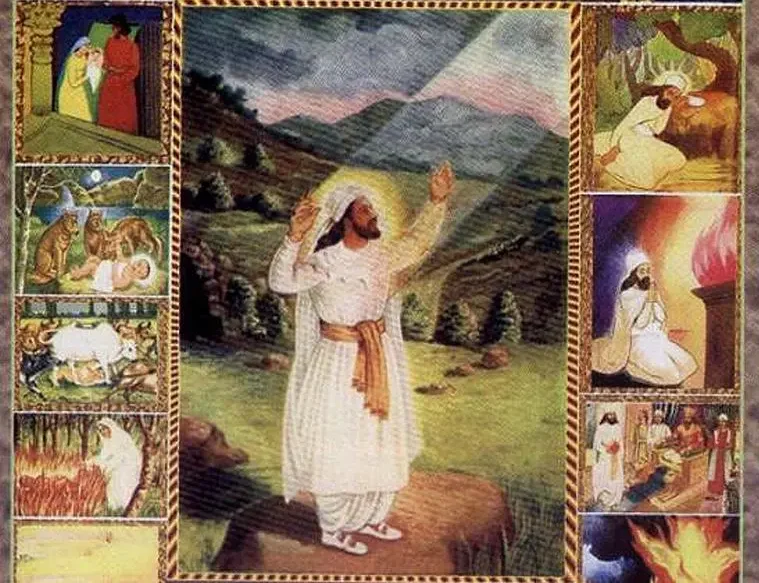Contenus
ToggleIn short
Zartosht no-diso, or Zarthost no deeso, is an important day of commemoration in the Zoroastrian religion. It is a commemoration of the death anniversary of the prophet Zoroaster. It is observed on the 11th day (Khorshed) of the 10th month (Dae). In the seasonal calendar, Zarthost No-Diso falls on December 26.

Zartosht no-diso, the death of the prophet Zoroaster
It is an occasion of commemoration with lectures and discussions on the life and works of the prophet. The attendance at the fire temple is very high on this occasion. A much larger number of mobeds are taken to pray at the Atash Behrams and Atash Adarans. There is no mourning in the Zoroastrian religion, only remembrance and worship of the Farohars of the deceased.
However, Zoroaster's death is not mentioned in the Avesta. However, in Shahnama 5.92, he is said to have been murdered at the altar by the Turanians during the capture of Balkh.
Some bits of his life are known thanks to the Gathic hymns (in Persian گاتاها) of the Avesta (in Persian اوستا), written in an archaic Indo-Iranian language, old before the 10th century BCE, Avestan. This is very close to the Indian Vedic texts of Rig-Veda. We also know him through the tradition which relates an epic story of his life, like an exemplary scenario filled with supernatural events and miracles. He is therefore perceived as a historical character, but the dates about him are much debated.
Zoroaster, known as "son of Ormuzd", "son of Horomasde" or "son of Puruchaspa", which is a metaphor because this name is not that of his biological father but of his divinity, Ohrmazd, would have started his life as a priest of the religion then reigning in Persian, Mazdaism, which included, among other things, numerous sacrificial rites, particularly of animals. He had a series of visions, in which he saw Ahura Mazda (Persian: اهورامزدا), supreme deity, and then began passionate preaching, preaching:
- the coming of the Kingdom of Justice, cooperation in the work of God (Ahura Mazda), under penalty of total punishment;
- the god Ahura Mazda, elevated to the rank of supreme god, relegating the other deities of the religion to a secondary rank;
- a form of monotheism (Ahura Mazda) and dualism at the same time, cosmic dualism (Holy Spirit/Evil Spirit) and ethical dualism (good/evil). This theme sows disagreement between scholars of Mazdaism: Plutarch is pro-dualism, Martin Haug pro-monotheism, Walter Henning pro-dualism, Gherardo Gnolli pro-monotheism, etc. So two Spirits, Angra Mainyu (the Evil Spirit, the Bad Thought; Ahriman in Middle Persian) and Spenta Mainyu (the Holy Spirit); Ahura Mazda is the father of Spenta Mainyu, Asha, Vohu Manah, Armaiti. And two choices: Asha (Accuracy) and Druj (Deception, Lies).
- criticism of the practices of traditional religion, notably the cult of Mithras (Mithraism) – which attracted the wrath of the priests – because these animal sacrifices were particularly cruel (due to his conviction that they too possessed a soul ) and that they constituted a source of income for religious leaders;
- the condemnation of the consumption of intoxicating drinks — haoma (cf. soma, in Sanskrit) -, which prevents man from thinking clearly and which was current in Mithraism.
was supported mainly by aristocratic warrior families. However, the arguments of justice and personal conscience deeply offended the customs and mentalities of these same old families. Not only were his ideas not popular, but above all they called into question established power. Chased by the people, he had to flee to save his life.
After several years of exile during which he would have had mystical conversations with Ahura Mazda, he ended up finding in Bactres a powerful protector, Hystaspes, the father of Darius I (6th century BC). Hystaspès will follow his teaching through an initiatory journey.
This first victory of Zoroaster will lead to others: Hystaspes forces his subjects, then the subjects he defeated in war, to convert to Zoroastrianism. La religion s’étendit, surtout en Perse et chez les Parthes qui en firent une religion officielle, et la dotèrent d’une véritable institution ecclésiastique – la caste des Mobads – qui eut une grande influence dans les affaires de l’État ainsi que la politique.
Social networks
and many religious communities commemorate the death of the prophet Zoroaster. Zoroastrianism is one of the oldest religions still in operation, estimated to be over 5000 years old. She is the ancestor of Abrahamic religions, dualistic religions and many others. It was repeatedly used as a revolution of the people against the aristocracy. #mythology #myth #legend #calendar #26December #zoroaster #zoroaster
Picture
